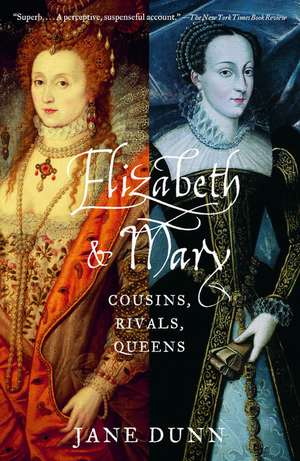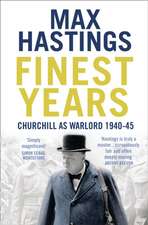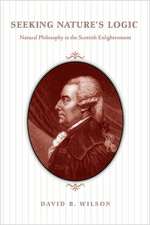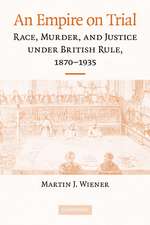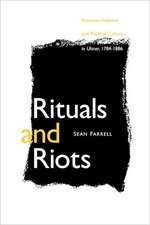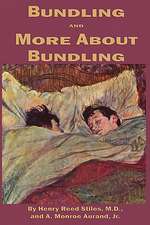Elizabeth and Mary: Cousins, Rivals, Queens
Autor Jane Dunnen Limba Engleză Paperback – 30 noi 2004 – vârsta de la 14 până la 18 ani
Against the backdrop of sixteenth-century England, Scotland, and France, Dunn paints portraits of a pair of protagonists whose formidable strengths were placed in relentless opposition. Protestant Elizabeth, the bastard daughter of Anne Boleyn, whose legitimacy had to be vouchsafed by legal means, glowed with executive ability and a visionary energy as bright as her red hair. Mary, the Catholic successor whom England’s rivals wished to see on the throne, was charming, feminine, and deeply persuasive. That two such women, queens in their own right, should have been contemporaries and neighbours sets in motion a joint biography of rare spark and page-turning power.
Preț: 125.59 lei
Nou
Puncte Express: 188
Preț estimativ în valută:
24.03€ • 25.16$ • 19.88£
24.03€ • 25.16$ • 19.88£
Carte indisponibilă temporar
Doresc să fiu notificat când acest titlu va fi disponibil:
Se trimite...
Preluare comenzi: 021 569.72.76
Specificații
ISBN-13: 9780375708206
ISBN-10: 0375708200
Pagini: 480
Ilustrații: 24 PP FULL-COLOR
Dimensiuni: 135 x 206 x 27 mm
Greutate: 0.47 kg
Ediția:Vintage Books.
Editura: Vintage Publishing
ISBN-10: 0375708200
Pagini: 480
Ilustrații: 24 PP FULL-COLOR
Dimensiuni: 135 x 206 x 27 mm
Greutate: 0.47 kg
Ediția:Vintage Books.
Editura: Vintage Publishing
Notă biografică
Jane Dunn is the author of Moon in Eclipse: A Life of Mary Shelley; A Very Close Conspiracy: Virginia Woolf and Vanessa Bell; Antonia White: A Life; and Read My Heart: A Love Story in England's Age of Revolution. She is a Fellow of the Royal Society of Literature, is married to the linguist and writer Nicholas Ostler, and lives in Bath, England.
Extras
The Fateful Step
"I am already bound unto an husband, which is the kingdom of England" ... Stretching out her hand she showed them the ring.
Queen Elizabeth's first speech before parliament,
10 February 1559
These were dangerous times. The second quarter of the sixteenth century had made Elizabeth Tudor and her generation of coming men watchful, insecure, fearful for their lives. Nothing could be taken for granted. Health and happiness were fleeting, reversals of fortune came with devastating speed. This was the generation raised in the last days of King Henry and come of age in a time of religious and political flux. The religious radicalism of Edward VI's reign had been quickly followed by reactionary extremism and bloodshed in Queen Mary's. During the political tumult of these years there was no better time for ambitious men to seize position, wealth and honours. No longer was power the exclusive prerogative of old aristocratic blood. When a Thomas Wolsey, son of a butcher, or a Thomas Cromwell, son of a blacksmith, could rise in Henry's reign to be the mightiest subject in the land, then what bar to ambition during the minority of Edward, the turmoil of Mary, and the unpromising advent of Elizabeth? But vaulting ambition and exorbitant rewards brought their own peril. The natural hierarchy of things mattered to the sixteenth-century mind. Men elevated beyond their due estate, women raised as rulers over men were unnatural events and boded ill. Those with the greatest aspirations could not expect to die peaceful in their beds.
God remained at the centre of this febrile and unpredictable world. His will was discerned in every random act. Death was everywhere. It came as sudden sweating sickness and struck down communities of healthy adults. It came as fire to purify heretic beliefs. It came through poison or the deadly thrust of steel to dispose of inconvenient obstacles in the machinery of power. The supernatural had a physical presence, and spirits and magic were natural companions to everyday life. They were part of the grand cosmic scheme which constituted God's hierarchical universe. Analogy, interconnectedness, fixity were deeply impressive to the Elizabethan mind, mutability and disorder a sign of man out of harmony with God's plan. Superstition and religion were ways to make sense of suffering, attempts at warding off the apparently random blows of fate. Yet the insecurity of life itself made the living intense, the wits sharper, the senses more acute. For sixteenth-century men and women there was a life after death, for the godly well-mapped and glorious, but life on earth was a precious and precarious thing to be seized and drained to the dregs.
At a time of augury and superstition, there was nothing to foretell the events of 1558: no sightings of whales in the Channel; no preternaturally high tide, nor monstrous births nor the mysterious, lingering trajectory of a comet across the northern sky. Even Nostradamus, whose prophecies were consulted by those in a fever of uncertainty, appeared unaware of its significance. The year opened without cosmic fanfare. Yet this was to become one of the momentous dates in every British schoolchild's history rote. Along with the battle of Hastings of 1066 and the great fire of London in 1666, 1558 was one of the markers of a seismic shift in English experience, to be chanted in schoolrooms through subsequent centuries. It was a year of grand transfers of power, as one reign came to an end and a new era began. It was a time of inexorable religious schism, when universal monopolistic Catholicism was permanently supplanted by the state religion, Protestantism.
Scotland's most recent history had been less convulsive. By the beginning of 1558 it was balanced in a certain equilibrium. A significant number of lords had proceeded informally down the road of religious reformation and the opposing factions had forged an uneasy coexistence. Clan loyalties and rivalries would always be the defining identity which cut across ideology, matters of faith or political allegiance. Rather than a religious cause, any growing unrest and sense of danger came more from Scottish resentment against the increasing presence of the French, garrisoned in various towns and awarded lucrative offices over the heads of the native Scots. As a child ten years previously, Mary Queen of Scots had escaped the clutches of the English and sailed for France. Her French mother Mary of Guise was courageous and just as regent but inevitably favoured her own country with whom Scotland was in alliance. This cosy relationship was about to be challenged when, in 1559, the Reformation turned militant and anti-French, and John Knox, the inspired Calvinist preacher, returned home after twelve years' exile to become its hectoring mouthpiece.
At the beginning of 1558, however, both Elizabeth and Mary were poised on the margin between apprenticeship and their public lives as female monarchs. By the end of that year both had embraced their fate. The defining moment for Mary came with a kiss-in effect a marriage. For Elizabeth it came with a death-and an exclusive contract with her people.
It was apparent that a woman in possession of a throne must marry, and do so without delay. All biblical and classical texts, in which the educated sixteenth-century mind was imbued, stressed the natural order of the male's dominion over the female. A female monarch was a rare and unnatural phenomenon which could only be regularised by speedy union with a prince who would rule over her in private and guide her in her public, God-given, role as queen. Only by restoring man's necessary dominion could the proper balance of the world be maintained.
Although her cousin Elizabeth was revolutionary in her lifelong resistance to this obligation, Mary Stuart was more conformable and fulfilled this expectation of her status and sex-not once but three times. In early 1558 she was fifteen and had been a queen since she was six days old. She had never known any other state. First as a queen of Scotland, the land of her birth and a country she did not know: secondly as queen of France, the country of her heart. Having lived from the age of five at the centre of the powerful French court, Mary had grown into a charming and accomplished French princess, destined to become the wife of the dauphin of France. Her spectacular dynastic marriage, reinforcing the "auld alliance" between Scotland and France, was set for the spring. Mary would marry her prince on 24 April 1558. François, the beloved companion of her childhood and King Henri II's eldest son, was just fourteen years old.
In England, Elizabeth Tudor was twenty-four years old and living quietly in the country at Hatfield some thirty miles north of London. Expectant, and fearful of losing the one thing she desired, she was fearful too of its fulfilment. She had already been bastardised, disinherited, often in danger and always waiting, never certain of the prize. Elizabeth had seen her two siblings (and a cousin, fleetingly) succeed to the throne before her. If any had had children then her position on the sidelines of power would have become permanent. But Edward VI died in 1553 unmarried and childless aged sixteen. He was followed not by either of his elder half-sisters but by their hapless teenage cousin, Lady Jane Grey. Sacrificed to further the ambitions of her father-in-law, the Duke of Northumberland, she was queen in name only and then barely for nine days. Immediately imprisoned she was executed seven months later. Now in 1558, Henry VIII's eldest child, Mary I, herself appeared to be ailing.
Elizabeth had survived much danger. She knew well how closely scrutinised her actions were and how much she was the focus of others' desire for power. The previous two decades had seen so many ambitions crumble to dust, so many noblemen and women imprisoned and beheaded, accused of heresy or treason, tortured, tried and burnt, or if a traitor, hung, drawn and quartered, in the terrific ways of judicial death.
At the beginning of 1558, Elizabeth and her supporters knew that some great change was in motion. But change brought disruption too and increased danger. Her half-sister Mary Tudor had been queen for nearly five years. Suspicious, suffering, devoutly Catholic and zealous to maintain the supremacy of the old faith, her reign had grown increasingly unhappy. Mary's worst mistake had been her insistence on marrying Philip II of Spain, for the English hated foreigners meddling in their affairs, and they hated the Spanish most of all.
The fanatical purges of heresy by her decree, and the torture and burnings of hundreds of martyrs, would earn Mary the epithet "Bloody Mary" from generations to come. The country grew ever more tired and repelled by the bloodshed. The dreadful spectacles had become counter-productive, alienating her subjects' affections for their queen and strengthening the reformers' support. In reaction to the mood of the country, the burnings in Smithfield were halted in June 1558. But nature seemed to be against Mary too, for the harvests also failed two years in succession. In 1556 people were scrabbling like pigs for acorns and dying of starvation. The following year they were ravaged by disease as various epidemics swept through the land. Famine and pestilence-people wondered, was this God's retribution for the sins of Mary's reign?
By the beginning of 1558, Mary was herself sick and in despair. Still longing for a child and heir, once more in desperation she had made herself believe she was pregnant again. But Philip had not bothered to hide his antipathy to his queen and anyway had been absent from her for too long. Her delusion and humiliation was evident even to her courtiers. Elizabeth, who had waited so long in an uneasy limbo, under constant suspicion, her sister refusing to name her as her heir, would have lost everything if this miraculous pregnancy turned out to bear fruit. No one could know, however, that the symptoms which Mary interpreted as the beginning of new life and hope were instead harbingers of death.
The Queen's spirit that cold January had already been broken over the loss of Calais. The last trophy left to the English from their ancient wars with France, this two-century-old possession had been lost in the very first days of the year. Since the previous June, Mary had supported her husband by embroiling her country in an expensive, unpopular and now ultimately humiliating war with France. The loss to their old enemy of Calais, remnant of Plantagenet prowess, was more a symbolic than strategic catastrophe, and it cut her to the heart.
This latest humiliation of English pride had been inflicted by François, Duc de Guise, nicknamed le Balafré, "scarface," after a wound inflicted by the English at the siege of Boulogne fourteen years earlier. A lance had smashed through his face from cheek to cheek but he had overcome all odds and recovered his life, his sight, and even the desire to fight again. He was a brilliant soldier, and the eldest and most powerful of Mary Queen of Scots' six overweening Guise uncles. The ambition of these brothers knew no bounds. They claimed direct descendency from Charlemagne. Catholic conviction and imperial ambitions commingled in their blood. Their brotherhood made them daunting: they thought and hunted as a pack, their watchwords being "one for all" and "family before everything."
Taking advantage of their monarch's gratitude for the success of the Calais campaign and riding on a wave of popular euphoria, the Duc de Guise and his brother the Cardinal of Lorraine agitated for the marriage of their niece to the youthful heir to the French throne. The fortunes of the girl queen and the triumphant family of her mother, Mary of Guise, were fatally intertwined. At this time, the Guises seemed to be so much in the ascendant that many of their fellow nobles resented and envied their power, fearing that it was they who in effect ruled France.
Elizabeth and Mary Queen of Scots had always been aware of each other, of their kinship and relations to the English crown. As cousins, they were both descended from Henry VII, Elizabeth as his grand-daughter, Mary as his great-granddaughter. European royalty was a small, elite and intermarried band. As the subject of the English succession loomed again, Elizabeth was acutely conscious of the strength of the Queen of Scots' claim to the English throne. Certainly she knew that if her sister Mary I's repeal of Henry VIII's Act of Supremacy was allowed to stand then her own parents' marriage would remain invalid and she could be marginalised and disinherited as a bastard. To most Catholics Henry's marriage to Anne Boleyn had always been invalid and Mary Queen of Scots was legally and morally next in line to the English throne. If Mary united the thrones of Scotland, France and England then this would ensure that England remained a part of Catholic Christendom.
However, if the Acts of Mary Tudor's reign should be reversed, then Elizabeth's legitimacy was confirmed and she, as Henry VIII's legitimate daughter, had not only the natural but the more direct claim. She also had popular, emotional appeal. Her tall, regal figure and her reddish gold colouring reminded the people, grown nostalgic and selective in their memory of "Good King Harry," of her father when young. Her surprisingly dark eyes, an inheritance of the best feature of her mother Anne Boleyn, were not enough to blur the bold impression that the best of her father lived on in her.
In fact, despite the stain on her mother's name, it was to Elizabeth's credit that she was not the daughter of a foreign princess, that unadulterated English blood ran in her veins and that she had been born in Greenwich Palace, at the centre of English royal power. In early peace negotiations with France, Elizabeth had Cecil point out she was "descended by father and mother of mere English blood, and not of Spain, as her sister was." This meant she was "a free prince and owner of her crown and people." She was an Englishwoman, and she knew this counted for much in this island nation of hers. "Was I not born in the realm? Were my parents born in any foreign country? Is there any cause I should alienate myself from being careful over this country? Is not my kingdom here?"
At the beginning of the sixteenth century, a Venetian ambassador noted the insularity and self-satisfaction of the English even then:
the English are great lovers of themselves, and of everything belonging to them; they think that there are no other men than themselves, and no other world but England; and whenever they see a handsome foreigner, they say that "he looks like an En-glishman," and that "it is a great pity that he should not be an Englishman."
From the Hardcover edition.
"I am already bound unto an husband, which is the kingdom of England" ... Stretching out her hand she showed them the ring.
Queen Elizabeth's first speech before parliament,
10 February 1559
These were dangerous times. The second quarter of the sixteenth century had made Elizabeth Tudor and her generation of coming men watchful, insecure, fearful for their lives. Nothing could be taken for granted. Health and happiness were fleeting, reversals of fortune came with devastating speed. This was the generation raised in the last days of King Henry and come of age in a time of religious and political flux. The religious radicalism of Edward VI's reign had been quickly followed by reactionary extremism and bloodshed in Queen Mary's. During the political tumult of these years there was no better time for ambitious men to seize position, wealth and honours. No longer was power the exclusive prerogative of old aristocratic blood. When a Thomas Wolsey, son of a butcher, or a Thomas Cromwell, son of a blacksmith, could rise in Henry's reign to be the mightiest subject in the land, then what bar to ambition during the minority of Edward, the turmoil of Mary, and the unpromising advent of Elizabeth? But vaulting ambition and exorbitant rewards brought their own peril. The natural hierarchy of things mattered to the sixteenth-century mind. Men elevated beyond their due estate, women raised as rulers over men were unnatural events and boded ill. Those with the greatest aspirations could not expect to die peaceful in their beds.
God remained at the centre of this febrile and unpredictable world. His will was discerned in every random act. Death was everywhere. It came as sudden sweating sickness and struck down communities of healthy adults. It came as fire to purify heretic beliefs. It came through poison or the deadly thrust of steel to dispose of inconvenient obstacles in the machinery of power. The supernatural had a physical presence, and spirits and magic were natural companions to everyday life. They were part of the grand cosmic scheme which constituted God's hierarchical universe. Analogy, interconnectedness, fixity were deeply impressive to the Elizabethan mind, mutability and disorder a sign of man out of harmony with God's plan. Superstition and religion were ways to make sense of suffering, attempts at warding off the apparently random blows of fate. Yet the insecurity of life itself made the living intense, the wits sharper, the senses more acute. For sixteenth-century men and women there was a life after death, for the godly well-mapped and glorious, but life on earth was a precious and precarious thing to be seized and drained to the dregs.
At a time of augury and superstition, there was nothing to foretell the events of 1558: no sightings of whales in the Channel; no preternaturally high tide, nor monstrous births nor the mysterious, lingering trajectory of a comet across the northern sky. Even Nostradamus, whose prophecies were consulted by those in a fever of uncertainty, appeared unaware of its significance. The year opened without cosmic fanfare. Yet this was to become one of the momentous dates in every British schoolchild's history rote. Along with the battle of Hastings of 1066 and the great fire of London in 1666, 1558 was one of the markers of a seismic shift in English experience, to be chanted in schoolrooms through subsequent centuries. It was a year of grand transfers of power, as one reign came to an end and a new era began. It was a time of inexorable religious schism, when universal monopolistic Catholicism was permanently supplanted by the state religion, Protestantism.
Scotland's most recent history had been less convulsive. By the beginning of 1558 it was balanced in a certain equilibrium. A significant number of lords had proceeded informally down the road of religious reformation and the opposing factions had forged an uneasy coexistence. Clan loyalties and rivalries would always be the defining identity which cut across ideology, matters of faith or political allegiance. Rather than a religious cause, any growing unrest and sense of danger came more from Scottish resentment against the increasing presence of the French, garrisoned in various towns and awarded lucrative offices over the heads of the native Scots. As a child ten years previously, Mary Queen of Scots had escaped the clutches of the English and sailed for France. Her French mother Mary of Guise was courageous and just as regent but inevitably favoured her own country with whom Scotland was in alliance. This cosy relationship was about to be challenged when, in 1559, the Reformation turned militant and anti-French, and John Knox, the inspired Calvinist preacher, returned home after twelve years' exile to become its hectoring mouthpiece.
At the beginning of 1558, however, both Elizabeth and Mary were poised on the margin between apprenticeship and their public lives as female monarchs. By the end of that year both had embraced their fate. The defining moment for Mary came with a kiss-in effect a marriage. For Elizabeth it came with a death-and an exclusive contract with her people.
It was apparent that a woman in possession of a throne must marry, and do so without delay. All biblical and classical texts, in which the educated sixteenth-century mind was imbued, stressed the natural order of the male's dominion over the female. A female monarch was a rare and unnatural phenomenon which could only be regularised by speedy union with a prince who would rule over her in private and guide her in her public, God-given, role as queen. Only by restoring man's necessary dominion could the proper balance of the world be maintained.
Although her cousin Elizabeth was revolutionary in her lifelong resistance to this obligation, Mary Stuart was more conformable and fulfilled this expectation of her status and sex-not once but three times. In early 1558 she was fifteen and had been a queen since she was six days old. She had never known any other state. First as a queen of Scotland, the land of her birth and a country she did not know: secondly as queen of France, the country of her heart. Having lived from the age of five at the centre of the powerful French court, Mary had grown into a charming and accomplished French princess, destined to become the wife of the dauphin of France. Her spectacular dynastic marriage, reinforcing the "auld alliance" between Scotland and France, was set for the spring. Mary would marry her prince on 24 April 1558. François, the beloved companion of her childhood and King Henri II's eldest son, was just fourteen years old.
In England, Elizabeth Tudor was twenty-four years old and living quietly in the country at Hatfield some thirty miles north of London. Expectant, and fearful of losing the one thing she desired, she was fearful too of its fulfilment. She had already been bastardised, disinherited, often in danger and always waiting, never certain of the prize. Elizabeth had seen her two siblings (and a cousin, fleetingly) succeed to the throne before her. If any had had children then her position on the sidelines of power would have become permanent. But Edward VI died in 1553 unmarried and childless aged sixteen. He was followed not by either of his elder half-sisters but by their hapless teenage cousin, Lady Jane Grey. Sacrificed to further the ambitions of her father-in-law, the Duke of Northumberland, she was queen in name only and then barely for nine days. Immediately imprisoned she was executed seven months later. Now in 1558, Henry VIII's eldest child, Mary I, herself appeared to be ailing.
Elizabeth had survived much danger. She knew well how closely scrutinised her actions were and how much she was the focus of others' desire for power. The previous two decades had seen so many ambitions crumble to dust, so many noblemen and women imprisoned and beheaded, accused of heresy or treason, tortured, tried and burnt, or if a traitor, hung, drawn and quartered, in the terrific ways of judicial death.
At the beginning of 1558, Elizabeth and her supporters knew that some great change was in motion. But change brought disruption too and increased danger. Her half-sister Mary Tudor had been queen for nearly five years. Suspicious, suffering, devoutly Catholic and zealous to maintain the supremacy of the old faith, her reign had grown increasingly unhappy. Mary's worst mistake had been her insistence on marrying Philip II of Spain, for the English hated foreigners meddling in their affairs, and they hated the Spanish most of all.
The fanatical purges of heresy by her decree, and the torture and burnings of hundreds of martyrs, would earn Mary the epithet "Bloody Mary" from generations to come. The country grew ever more tired and repelled by the bloodshed. The dreadful spectacles had become counter-productive, alienating her subjects' affections for their queen and strengthening the reformers' support. In reaction to the mood of the country, the burnings in Smithfield were halted in June 1558. But nature seemed to be against Mary too, for the harvests also failed two years in succession. In 1556 people were scrabbling like pigs for acorns and dying of starvation. The following year they were ravaged by disease as various epidemics swept through the land. Famine and pestilence-people wondered, was this God's retribution for the sins of Mary's reign?
By the beginning of 1558, Mary was herself sick and in despair. Still longing for a child and heir, once more in desperation she had made herself believe she was pregnant again. But Philip had not bothered to hide his antipathy to his queen and anyway had been absent from her for too long. Her delusion and humiliation was evident even to her courtiers. Elizabeth, who had waited so long in an uneasy limbo, under constant suspicion, her sister refusing to name her as her heir, would have lost everything if this miraculous pregnancy turned out to bear fruit. No one could know, however, that the symptoms which Mary interpreted as the beginning of new life and hope were instead harbingers of death.
The Queen's spirit that cold January had already been broken over the loss of Calais. The last trophy left to the English from their ancient wars with France, this two-century-old possession had been lost in the very first days of the year. Since the previous June, Mary had supported her husband by embroiling her country in an expensive, unpopular and now ultimately humiliating war with France. The loss to their old enemy of Calais, remnant of Plantagenet prowess, was more a symbolic than strategic catastrophe, and it cut her to the heart.
This latest humiliation of English pride had been inflicted by François, Duc de Guise, nicknamed le Balafré, "scarface," after a wound inflicted by the English at the siege of Boulogne fourteen years earlier. A lance had smashed through his face from cheek to cheek but he had overcome all odds and recovered his life, his sight, and even the desire to fight again. He was a brilliant soldier, and the eldest and most powerful of Mary Queen of Scots' six overweening Guise uncles. The ambition of these brothers knew no bounds. They claimed direct descendency from Charlemagne. Catholic conviction and imperial ambitions commingled in their blood. Their brotherhood made them daunting: they thought and hunted as a pack, their watchwords being "one for all" and "family before everything."
Taking advantage of their monarch's gratitude for the success of the Calais campaign and riding on a wave of popular euphoria, the Duc de Guise and his brother the Cardinal of Lorraine agitated for the marriage of their niece to the youthful heir to the French throne. The fortunes of the girl queen and the triumphant family of her mother, Mary of Guise, were fatally intertwined. At this time, the Guises seemed to be so much in the ascendant that many of their fellow nobles resented and envied their power, fearing that it was they who in effect ruled France.
Elizabeth and Mary Queen of Scots had always been aware of each other, of their kinship and relations to the English crown. As cousins, they were both descended from Henry VII, Elizabeth as his grand-daughter, Mary as his great-granddaughter. European royalty was a small, elite and intermarried band. As the subject of the English succession loomed again, Elizabeth was acutely conscious of the strength of the Queen of Scots' claim to the English throne. Certainly she knew that if her sister Mary I's repeal of Henry VIII's Act of Supremacy was allowed to stand then her own parents' marriage would remain invalid and she could be marginalised and disinherited as a bastard. To most Catholics Henry's marriage to Anne Boleyn had always been invalid and Mary Queen of Scots was legally and morally next in line to the English throne. If Mary united the thrones of Scotland, France and England then this would ensure that England remained a part of Catholic Christendom.
However, if the Acts of Mary Tudor's reign should be reversed, then Elizabeth's legitimacy was confirmed and she, as Henry VIII's legitimate daughter, had not only the natural but the more direct claim. She also had popular, emotional appeal. Her tall, regal figure and her reddish gold colouring reminded the people, grown nostalgic and selective in their memory of "Good King Harry," of her father when young. Her surprisingly dark eyes, an inheritance of the best feature of her mother Anne Boleyn, were not enough to blur the bold impression that the best of her father lived on in her.
In fact, despite the stain on her mother's name, it was to Elizabeth's credit that she was not the daughter of a foreign princess, that unadulterated English blood ran in her veins and that she had been born in Greenwich Palace, at the centre of English royal power. In early peace negotiations with France, Elizabeth had Cecil point out she was "descended by father and mother of mere English blood, and not of Spain, as her sister was." This meant she was "a free prince and owner of her crown and people." She was an Englishwoman, and she knew this counted for much in this island nation of hers. "Was I not born in the realm? Were my parents born in any foreign country? Is there any cause I should alienate myself from being careful over this country? Is not my kingdom here?"
At the beginning of the sixteenth century, a Venetian ambassador noted the insularity and self-satisfaction of the English even then:
the English are great lovers of themselves, and of everything belonging to them; they think that there are no other men than themselves, and no other world but England; and whenever they see a handsome foreigner, they say that "he looks like an En-glishman," and that "it is a great pity that he should not be an Englishman."
From the Hardcover edition.
Recenzii
“A perceptive, suspenseful account of complex English history. . . . By the end of this satisfying book, one feels sympathy for both women, brave queens in an age when ‘no one considered that a woman could effectively rule alone.’ ” —The New York Times Book Review
“Elegant. . . . Dunn demythologizes Elizabeth and Mary. In humanizing their dynamic and shifting relationship, Dunn describes it as fueled by both rivalry and their natural solidarity as women in an overwhlemingly masculine world.” --Boston Herald
“A balanced, nuanced, and eminently clear account. . . . Brilliantly conceived, elegantly executed, and compellingly readable.” --Richmond Times-Dispatch
“A wholly engrossing and sumptuous retelling of a tale that entered legend even before its protagonists were dead.” --Newsday
“Elegant. . . . Dunn demythologizes Elizabeth and Mary. In humanizing their dynamic and shifting relationship, Dunn describes it as fueled by both rivalry and their natural solidarity as women in an overwhlemingly masculine world.” --Boston Herald
“A balanced, nuanced, and eminently clear account. . . . Brilliantly conceived, elegantly executed, and compellingly readable.” --Richmond Times-Dispatch
“A wholly engrossing and sumptuous retelling of a tale that entered legend even before its protagonists were dead.” --Newsday
Descriere
Descriere de la o altă ediție sau format:
This is the first biography of the fateful relationship between Elizabeth I and Mary Queen of Scots. It was the defining relationship of their lives, and marked the intersection of the great Tudor and Stuart dynasties, a landmark event in British history.
This is the first biography of the fateful relationship between Elizabeth I and Mary Queen of Scots. It was the defining relationship of their lives, and marked the intersection of the great Tudor and Stuart dynasties, a landmark event in British history.
